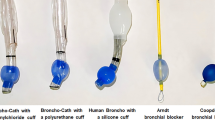Abstract
Laryngotracheal separation is a simple and reliable operation for the treatment of patients with repetitive and intractable aspiration; however, it is apprehended that pooling in the tracheal blind pouch may cause postoperative complications. In the present study, we examined drainage of the blind pouch created by laryngotracheal separation. Fourteen patients aged 3–63 years with repetitive aspiration pneumonia underwent laryngotracheal separation by the modified Lindeman procedure. A barium swallow was performed 10–30 days after surgery. X-rays of the lateral view of the neck were taken at 6 and 24 h after the swallow, and then every 24 h until the contrast medium cleared. The contrast medium in the blind pouch cleared within 24 h in nine patients. In the remaining five, the clearance time was ≤48 and ≤72 h in two patients each, and 96 h in one patient. The clearance time in patients aged under 20 years was ≤24 h, while middle-aged to elderly patients showed prolonged clearance time. No late complications of the blind pouch, such as infections, were observed. The potential risk of complications caused by pooling in the tracheal blind pouch in laryngotracheal separation is prevented presumably due to the slow but continuous turnover of pooling material. This result supports the validity and usefulness of laryngotracheal separation for the treatment of intractable aspiration.


Similar content being viewed by others
References
Montgomery WW (1975) Surgery to prevent aspiration. Arch Otolaryngol 101:679–682
Sasaki CT, Milmoe G, Yanagisawa E, Berry K, Kirchner JA (1980) Surgical closure of the larynx for intractable aspiration. Arch Otolaryngol 106:422–423
Habal MB, Murray JE (1972) Surgical treatment of life-endangering chronic aspiration pneumonia. Use of an epiglottic flap to the arytenoids. Plast Reconstr Surg 49:305–311. doi:10.1097/00006534-197203000-00011
Biller HF, Lawson W, Baek SM (1983) Total glossectomy: a technique of reconstruction eliminating laryngectomy. Arch Otolaryngol 109:69–73
Lindeman RC (1975) Diverting the paralyzed larynx: a reversible procedure for intractable aspiration. Laryngoscope 85:157–180. doi:10.1288/00005537-197501000-00012
Lindeman RC, Yarington CT Jr, Sutton D (1976) Clinical experience with the tracheoesophageal anastomosis for intractable aspiration. Ann Otol Rhinol Laryngol 85:609–612
Yamana T, Kitano H, Hanamitsu M, Kitajima K (2001) Clinical outcome of laryngotracheal separation for intractable aspiration pneumonia. ORL J Otorhinolaryngol Relat Spec 63:321–324. doi:10.1159/000055766
Krespi YP, Quatela VC, Sisson GA, Som ML (1984) Modified tracheoesophageal diversion for chronic aspiration. Laryngoscope 94:1298–1301. doi:10.1288/00005537-198410000-00007
Nakasaki H, Sugihara T, Tajima T, Mitomi T, Osamura Y, Onoda N, Fujii K (1991) Tracheoesophageal anastomosis for intractable aspiration pneumonia. Ann Thorac Surg 51:23–29
Baron BC, Dedo HH (1980) Separation of the larynx and trachea for intractable aspiration. Laryngoscope 90:1927–1932. doi:10.1288/00005537-198012000-00002
Cohen SR, Thompson JW (1987) Variants of Mobius’ syndrome and central neurologic impairment. Ann Otol Rhinol Laryngol 96:93–100
Lawless ST, Cook S, Luft J, Jasani M, Kettrick R (1995) The use of a laryngotracheal separation procedure in pediatric patients. Laryngoscope 105:198–202. doi:10.1288/00005537-199502000-00017
Cook SP, Lawless ST, Kettrick R (1996) Patient selection for primary laryngotracheal separation as treatment of chronic aspiration in the impaired child. Int J Pediatr Otorhinolaryngol 38:103–113. doi:10.1016/S0165-5876(96)01422-X
Takamizawa S, Tsugawa C, Nishijima E, Muraji T, Satoh S (2003) Laryngotracheal separation for intractable aspiration pneumonia in neurologically impaired children: experience with 11 cases. J Pediatr Surg 38:975–977. doi:10.1016/S0022-3468(03)00137-4
Manrique D, Settanni FA, Campones do Brasil Ode O (2006) Surgery for aspiration: analysis of laryngotracheal separation in 23 children. Dysphagia 21:254–258. doi:10.1007/s00455-006-9048-1
Snyderman CH, Johnson JT (1988) Laryngotracheal separation for intractable aspiration. Ann Otol Rhinol Laryngol 97:466–470
Eisele DW, Yarington CT Jr, Lindeman RC (1988) Indications for the tracheoesophageal diversion procedure and the laryngotracheal separation procedure. Ann Otol Rhinol Laryngol 97:471–475
Eisele DW, Yarington CT Jr, Lindeman RC, Larrabee WF Jr (1989) The tracheoesophageal diversion and laryngotracheal separation procedures for treatment of intractable aspiration. Am J Surg 157:230–236. doi:10.1016/0002-9610(89)90534-5
Eibling DE, Snyderman CH, Eibling C (1995) Laryngotracheal separation for intractable aspiration: a retrospective review of 34 patients. Laryngoscope 105:83–85. doi:10.1288/00005537-199501000-00018
Zocratto OB, Savassi-Rocha PR, Paixao RM, Salles JM (2006) Laryngotracheal separation surgery: outcome in 60 patients. Otolaryngol Head Neck Surg 135:571–575. doi:10.1016/j.otohns.2006.05.018
Conflict of interest statement
We declare that there is no conflict of interests as to the manuscript entitled “Drainage of the tracheal blind pouch created by laryngotracheal separation”.
Author information
Authors and Affiliations
Corresponding author
Rights and permissions
About this article
Cite this article
Suzuki, H., Hiraki, N., Murakami, C. et al. Drainage of the tracheal blind pouch created by laryngotracheal separation. Eur Arch Otorhinolaryngol 266, 1279–1283 (2009). https://doi.org/10.1007/s00405-009-0942-7
Received:
Accepted:
Published:
Issue Date:
DOI: https://doi.org/10.1007/s00405-009-0942-7




